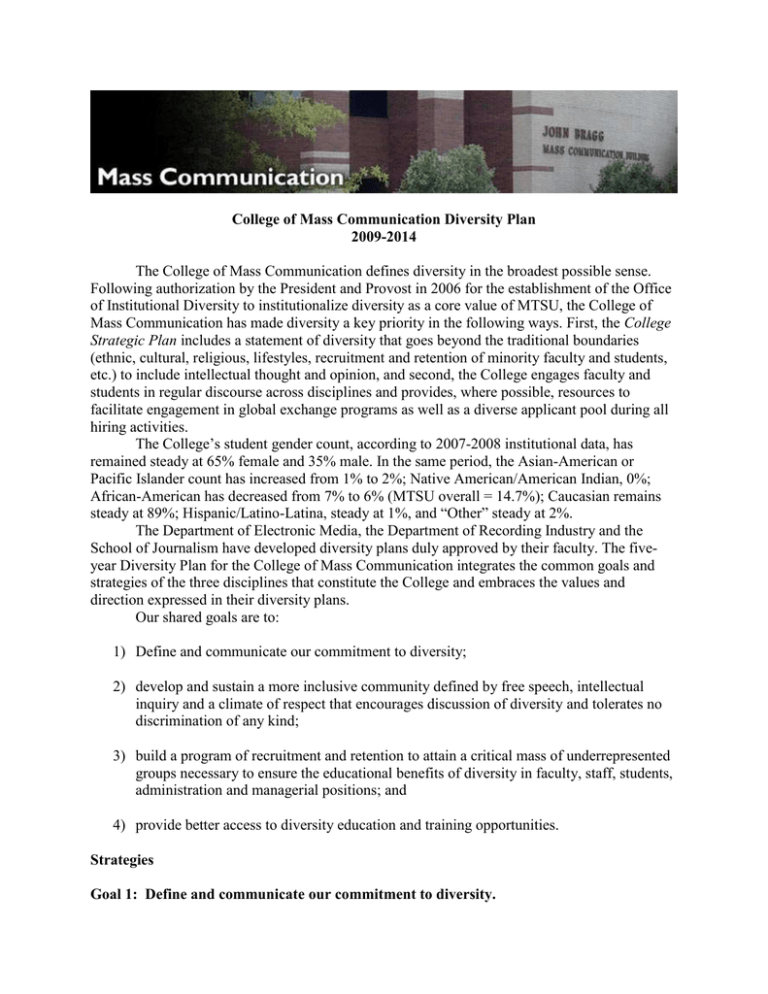College of Mass Communication Diversity Plan 2009-2014
advertisement

College of Mass Communication Diversity Plan 2009-2014 The College of Mass Communication defines diversity in the broadest possible sense. Following authorization by the President and Provost in 2006 for the establishment of the Office of Institutional Diversity to institutionalize diversity as a core value of MTSU, the College of Mass Communication has made diversity a key priority in the following ways. First, the College Strategic Plan includes a statement of diversity that goes beyond the traditional boundaries (ethnic, cultural, religious, lifestyles, recruitment and retention of minority faculty and students, etc.) to include intellectual thought and opinion, and second, the College engages faculty and students in regular discourse across disciplines and provides, where possible, resources to facilitate engagement in global exchange programs as well as a diverse applicant pool during all hiring activities. The College’s student gender count, according to 2007-2008 institutional data, has remained steady at 65% female and 35% male. In the same period, the Asian-American or Pacific Islander count has increased from 1% to 2%; Native American/American Indian, 0%; African-American has decreased from 7% to 6% (MTSU overall = 14.7%); Caucasian remains steady at 89%; Hispanic/Latino-Latina, steady at 1%, and “Other” steady at 2%. The Department of Electronic Media, the Department of Recording Industry and the School of Journalism have developed diversity plans duly approved by their faculty. The fiveyear Diversity Plan for the College of Mass Communication integrates the common goals and strategies of the three disciplines that constitute the College and embraces the values and direction expressed in their diversity plans. Our shared goals are to: 1) Define and communicate our commitment to diversity; 2) develop and sustain a more inclusive community defined by free speech, intellectual inquiry and a climate of respect that encourages discussion of diversity and tolerates no discrimination of any kind; 3) build a program of recruitment and retention to attain a critical mass of underrepresented groups necessary to ensure the educational benefits of diversity in faculty, staff, students, administration and managerial positions; and 4) provide better access to diversity education and training opportunities. Strategies Goal 1: Define and communicate our commitment to diversity. 2 Strategy 1: Develop a College mission statement that integrates diversity as a core value and supports discipline-specific initiatives. Strategy 2: Produce public documents such as annual reports, Web sites, newsletters and other media-related materials that express a commitment to diversity. Strategy 3: Establish a visual showcase of multicultural approaches and perspectives in hallway and building displays, as well as faculty/student galleries of creative work. Goal 2: Develop and sustain a more inclusive community defined by free speech, intellectual inquiry and a climate of respect that encourages discussion of diversity and tolerates no discrimination of any kind. Strategy 1: Invite industry leaders (print media, advertising, public relations, media design, recording industry, radio, television and other electronic media, etc.) who demonstrate dedication to the best practices of diversity and equity. Strategy 2: Use faculty and administrative meetings and retreats as opportunities to discuss issues of diversity and fairness. Strategy 3: Develop a culture and framework of thinking that equates excellence in mass communication education with fairness and diversity. Strategy 4: Use curricular materials to integrate diversity practices into daily College and University life. Strategy 5: Conduct a comprehensive review of all syllabi in Fall 2010 to benchmark how and where diversity is incorporated in the classroom. Based on results, the College -through its two departments and School -- can take appropriate action to strengthen and consistently monitor the inclusion of diversity in the curriculum. Strategy 6: Intensify the College’s mentoring program for new untenured faculty with special attention to the challenges faced by faculty of color, female faculty and others who may require or benefit from additional support. Strategy 7: Discuss issues of diversity–successes, initiatives and opportunities -- at Board of Professional Advisers meetings, student awards/Wall of Fame ceremonies, alumni and graduation events, etc. Strategy 8: Create opportunities such as monthly “brown bags” with faculty for initiatives that work in incorporating diversity in their classes and with student organizational meetings for the discussion of diversity. 3 Strategy 9: Encourage faculty advisers of student organizations to devote a certain number of chapter meetings (minimum of one per semester) to the discussion of diversity. Strategy 10: Track the topics, speakers and minority participation in College-sponsored or initiated events and aim for approximately 25-30 percent minority representation at these events. Goal 3: Build a program of recruitment and retention to attain a critical mass of underrepresented groups. Strategy 1: Host on- and off-campus student recruitment programs, conferences, student organization events and job fairs, and encourage participation in national organizations dedicated to the advancement of minority scholars. Strategy 2: Communicate clear charges for faculty/staff search committees to seek a diverse applicant pool. Strategy 3: Improve gender and minority representation in the faculty. This means aiming for at least 25 percent minority representation among full-time/part-time faculty in each of the three areas that constitute the College. Strategy 4: Use data from MTSU’s Office of Institutional Diversity that track enrollment demographics to determine what student groups, by year, are underrepresented compared to their numbers in the state of Tennessee to guide targeted recruitment programs for prospective minority students. Strategy 5: Strengthen outreach programs to area high schools and provide mentoring of targeted prospective and existing minority student populations. Strategy 6: Based on retention and graduation rates, develop appropriate programs targeted at specific minority student groups in the College. Strategy 7: Disseminate information more widely about University programs such as the McNair Scholarship and provide an incentive system to increase student and faculty participation in these programs. Strategy 8: Establish need-based and merit scholarships for minority students and tap into financial resources that the Office of Institutional Diversity has identified for underrepresented student groups. Goal 4: Provide better access to diversity education and training. Strategy 1: Identify on- and off-campus programs for diversity education and training. 4 Strategy 2: Create incentives for faculty and staff participation at these diversity-training programs through grants or financial support as part of professional development. Strategy 3: Commit to sending 20 percent of tenured and tenure-track faculty to on- or off-campus diversity education/training each year so that in five years all faculty members of the College would attend one such training program.



